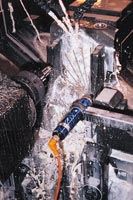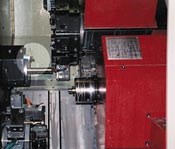Tool Monitoring May Be An Essential Part Of Unattended Machining
To take advantage of unattended machining, shops will most likely be forced to utilize some type of tool monitoring system.
To take advantage of unattended machining, shops will most likely be forced to utilize some type of tool monitoring system, says Steven Pechloff of TPS International, Inc. (Sussex, Wisconsin). A broken tool, left undetected, can result in significant losses that include scrapped workpieces, machine damage, chain-reaction cutting tool breakage and down time. Tool monitoring options "can really run the price spectrum" and so can the degree of knowledge necessary to use them properly, Mr. Pechloff observes.
In sheer numbers, the most popular type of system in use today, he says, is one that checks cylindrical shank tools such as drills, end mills, reamers and taps. According to Mr. Pechloff, TPS International supplies the metal cutting industry with a large percentage of these types of sensors. The system consists of three basic components: a sensing head with a light gauge needle, a control box and a cable connecting the two.
TPS's Positive Control Sensor (PCS) line monitors tools with a sensing needle that physically contacts the tip of the tool once per machine cycle. If the tool is present, the needle will contact the tool tip and return to its starting position. The cycle will then be allowed to continue. If the tool tip is broken, the needle will swing past the tool and interpret this condition as a broken tool. The unit will then send the appropriate stop signal (output) via the control box to stop the machine.
This type of sensor is used extensively on high volume production machines such as multi-spindle screw machines and transfer machines. It is also used for problem tools on CNC lathes and machining centers. "Original equipment manufacturers are looking for more affordable and reliable tool monitoring devices to satisfy quality ratings required by customers. In today's competitive markets, tool monitoring devices enable manufacturers to enhance quality while reducing costs," says Mr. Pechloff, who is PCS sales manager/mechanical engineer for TPS International.
He points out that, with a little imagination, tool monitors can be a big asset to unattended machining in other applications as well. For example, systems can be used to check material misfeed on bar machines, to confirm cut-off operations on lathes, to detect mis-chucked workpieces on automatic chucking routines, to monitor part pick-off on subspindle machines and to monitor numerous assembly operations.
"Considering the cost of machine downtime, machine damage, cutting tool damage, material scrap and sorting costs, tool monitoring becomes a necessity in eliminating new and repeat issues," says Mr. Pechloff. As he points out, "With systems now costing less than $800 and warranty existing beyond two years, tool monitoring is an option that must be considered when moving toward unattended machining.
Related Content
-
Tips for Designing CNC Programs That Help Operators
The way a G-code program is formatted directly affects the productivity of the CNC people who use them. Design CNC programs that make CNC setup people and operators’ jobs easier.
-
Continuous Improvement and New Functionality Are the Name of the Game
Mastercam 2025 incorporates big advancements and small — all based on customer feedback and the company’s commitment to keeping its signature product best in class.
-
Can AI Replace Programmers? Writers Face a Similar Question
The answer is the same in both cases. Artificial intelligence performs sophisticated tasks, but falls short of delivering on the fullness of what the work entails.

















